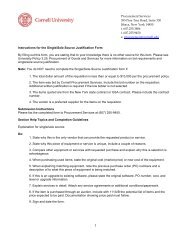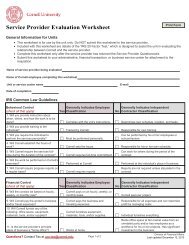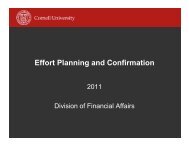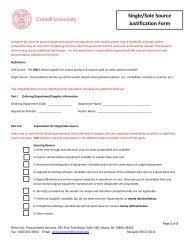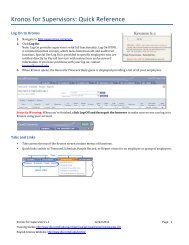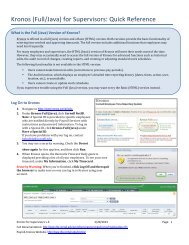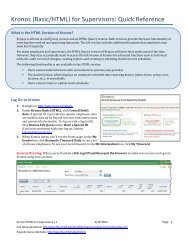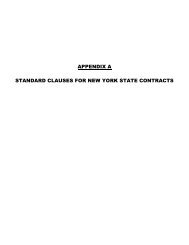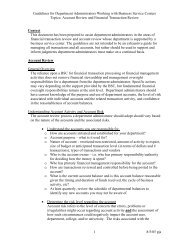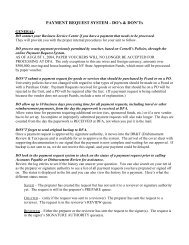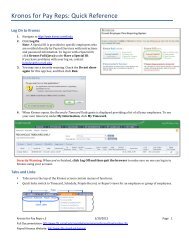Cornell University 2011-2012 Annual Report - DFA Home - Cornell ...
Cornell University 2011-2012 Annual Report - DFA Home - Cornell ...
Cornell University 2011-2012 Annual Report - DFA Home - Cornell ...
You also want an ePaper? Increase the reach of your titles
YUMPU automatically turns print PDFs into web optimized ePapers that Google loves.
NOTES TO CONSOLIDATED FINANCIAL STATEMENTS(dollars in thousands)3. INVESTMENTSA. General InformationThe <strong>University</strong>’s investments are overseen by the Investment Committee of the Board of Trustees. The <strong>University</strong>’s investmentstrategy incorporates a diversified asset allocation approach and maintains, within defined limits, exposure to themovements of the world equity, fixed income, commodities, real estate, and private equity markets. Based on guidelinesestablished by the Investment Committee, the <strong>University</strong>’s Investment Office directs the investment of endowment andtrust assets, certain working capital, and temporarily invested expendable funds.The <strong>University</strong> has categorized its investment assets in accordance with the fair-value measurement hierarchy. Thefollowing describes the hierarchy of inputs used to measure fair value; it also describes the primary valuation methodologiesused by the <strong>University</strong> for investment assets measured at fair value on a recurring basis.Fair value for Level 1 is based upon quoted prices in accessible active markets for identical assets. Market price data isgenerally obtained from exchange or dealer markets. The <strong>University</strong> does not adjust the quoted price for such assets.Fair value for Level 2 is based upon quoted prices for similar instruments in active markets, quoted prices for identicalor similar instruments in markets that are not active, and model-based valuation techniques for which all significantassumptions are observable in the market or can be corroborated by observable market data. Inputs are obtained fromvarious sources, including market participants, dealers, and brokers. In determining fair value of financial instruments,the <strong>University</strong> considers factors such as interest rate yield curves, duration of the instrument, and counterparty credit risk.The fair value of Level 2 instruments is determined using multiple valuation techniques including the market approach,income approach, or cost approach.Fair value for Level 3 is based upon valuation techniques that use significant inputs that are unobservable.Investments included in Level 3 consist primarily of the <strong>University</strong>’s ownership in alternative investments (principallylimited partnership interests in hedge, private equity, real estate, and other similar funds). The fair value of certain alternativeinvestments represents the ownership interest in the net asset value (NAV) of the respective partnership. The NAV ofthese investments is determined by the general partner, and is based upon appraisal or other estimates that require varyingdegrees of judgment. If no public market exists for the investment securities, the fair value is determined by the generalpartner taking into consideration, among other things, the cost of the securities, prices of recent significant placementsof securities of the same issuer, and subsequent developments concerning the companies to which the securities relate.The <strong>University</strong> has performed significant due diligence around these investments to ensure that NAV is an appropriatemeasure of fair value as of June 30.The <strong>University</strong> uses the NAV to determine the fair value of all alternative investments that do not have a readily determinablefair value and that have financial statements consistent with the measurement principles of an investment company or havethe attributes of an investment company. Investments that can be redeemed at NAV by the <strong>University</strong> on the measurementdate or in the near term, 90 days or less, are classified as Level 2. Investments that cannot be redeemed on the measurementdate or in the near term are classified as Level 3.The methods described above may produce a fair-value calculation that is not indicative of net realizable value or reflectiveof future fair values. Furthermore, while the <strong>University</strong> believes its valuation methods are appropriate and consistent withother market participants, the use of different methodologies or assumptions to determine the fair value of certain financialinstruments could result in a different estimate of fair value at the reporting date.19



